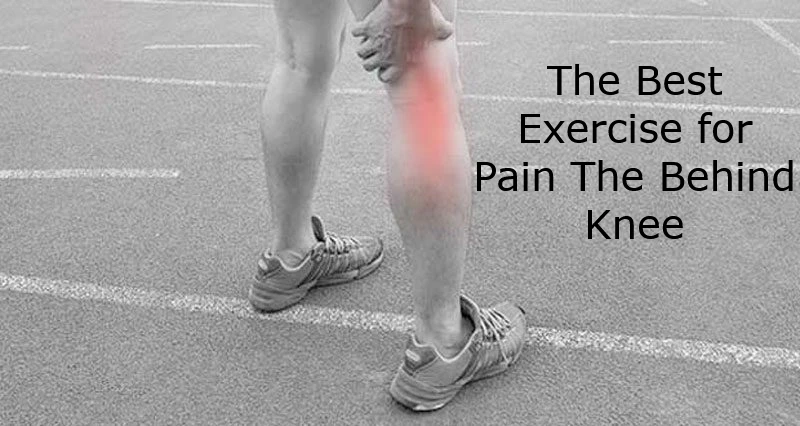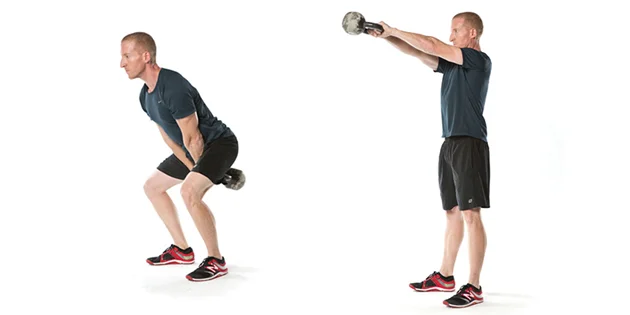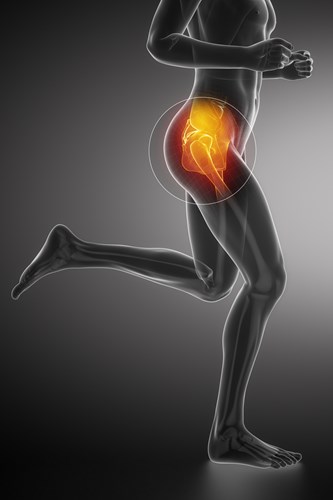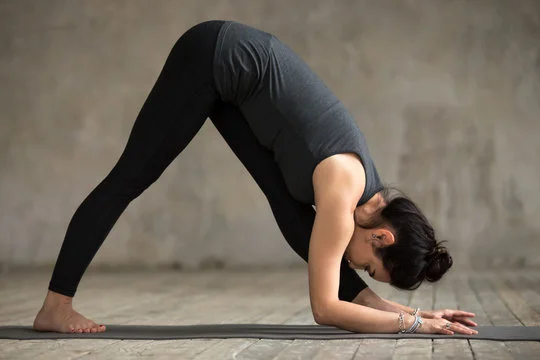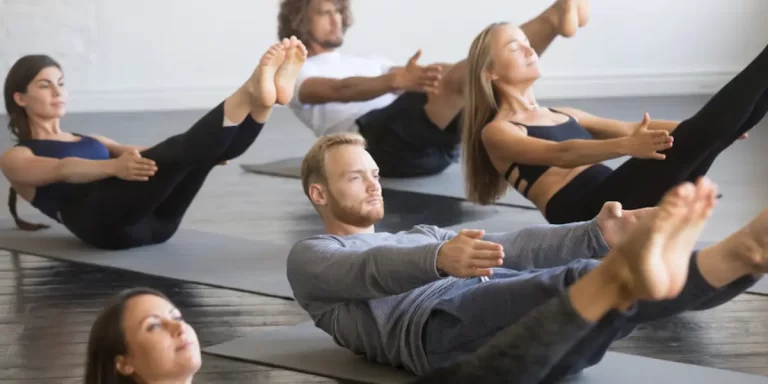18 Best Exercises For Pain Behind The Knee
Introduction
Pain behind the knee can be attributed to various factors, including overuse, injury, or underlying medical conditions. Engaging in specific exercises can help alleviate discomfort and promote flexibility and strength in the affected area.
Pain Behind The Knee may be treated in a number of methods, such as Pain Medication, Physical Therapy, strengthening exercises, and stretches.
Whether you’re an avid hiker, weekend warrior, or competitive athlete, knee discomfort might make it difficult to do some of your favorite things. This covers discomfort brought on by:
- Hyperuse arthritis
- Knee ligament sprains
- Meniscus tears
- Bursitis, and Tendinitis
Possessing strong, flexible muscles and joints that can withstand tension and damage is the strongest defense against injury. Certain activities can help reduce certain pain episodes with basic forms of knee discomfort. Never engage in physical activity that makes you more uncomfortable.
Knee Pain and Exercise
- Gentle stretching and strengthening exercises can help reduce knee discomfort and improve range of motion and flexibility if the cause is arthritis, surgery, or an injury.
- It may seem paradoxical to exercise an injured or arthritic knee, yet doing so is healthier for your knee than doing nothing. Your knee may tighten up if you don’t move it, making the discomfort worse.
- The muscles that support your knee joint can be strengthened with mild stretching and strengthening activities. Stronger muscles can facilitate easier knee joint movement and lessen the strain and pressure on your knee.
- A physician could advise imaging if your knee pain is significant in order to assess the degree of the injury.
- This blog post examines a range of knee pain exercises that are intended to assist you in returning to your regular activities. Please keep in mind that these are general exercises, so before starting any of them, be sure you speak with your physiotherapist.
- As physiotherapists, we meet a lot of patients with knee pain when they visit our clinic; in fact, almost 30% of young adults and 46% of persons over 50 report having knee discomfort.
- People of all ages can have crippling knee pain, which can be brought on by a number of conditions like arthritis, overuse, or previous injuries. The good news is that there are workouts that can strengthen and increase the flexibility of the knee joint while also reducing discomfort.
- These exercises will help you restore your range of motion and enhance your general quality of life, regardless of whether you are recuperating from an accident or managing persistent knee discomfort.
Knee stretches
- Lower-body stretching exercises have been shown by the American Academy of Orthopaedic Surgeons to enhance knee joint flexibility and range of motion.
- This may cause your knee to move more readily.
- Try to warm up for at least five to ten minutes before stretching. Good warm-up alternatives are low-impact exercises like walking, utilizing an elliptical machine, or riding a stationary bike.
- The following stretches should be performed after you’ve warmed up and before the knee-strengthening exercises.
- Make an effort to perform these stretches and workouts four or five times a week minimum.
Exercises for strengthening
- Working the muscles surrounding your knee on a daily basis will help lessen the strain on your knee joint, according to the American Academy of Orthopaedic Surgeons.
- Concentrate on exercises that build your hip, quadriceps, glutes, and hamstrings to help strengthen your knees.
Best Exercises For Pain Behind The Knee
Following are the Best exercises that Help to relieve Pain, Strengthen Knee Muscles, and improve flexibility.
Calf and heel stretch
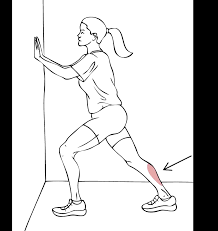
Your calf muscles, in particular, are the muscles in your lower leg that are being stretched.
Steps To Follow:
- Place yourself facing a wall.
- Keep your hands on the surface and take as many steps back as feels comfortable.
- Your knees should be slightly bent,
- Your heels should be flat and your toes pointing forward.
- Take a 30-second breath hold and lean into the stretch. Your rear leg should be feeling stretched.
- Repeat with a different pair of legs.
- On each leg, perform this stretch twice.
Quadriceps stretch

Your quadriceps, or the muscles in front of your thighs, are the focus of this stretch. Your quadriceps and hip flexors will become more flexible if you perform this exercise.
Steps To Follow:
- Use a chair or stand close to a wall for support. Place your feet shoulder-width apart.
- Your foot should come up near your glutes when you bend one knee.
- As far as it is comfortable for you, grab your ankle and slowly bring it toward your glutes.
- For 30 seconds, hold.
- Go back to the beginning and switch your legs.
Hamstring stretch
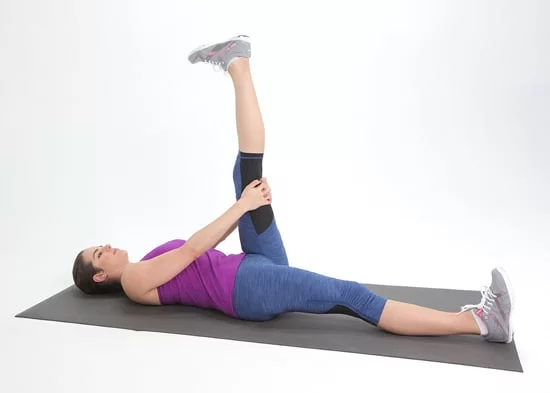
Your hamstrings, or the muscles at the rear of your thigh, are the focus of this stretch.
Feel this stretch at the back of your leg and all the way up to your glutes. Your calves may also feel stretched when you flex your foot.
Steps To Follow:
- One can use a pad below this stretch to provide some cushioning for your back
- Straighten both of your legs while you lie on the mat or the floor. You can also bend both knees with your feet flat on the floor if that seems more comfortable.
- Take a single leg off the ground.
- Gently lift your knee toward your chest until you feel a tiny stretch with your hands behind your thigh but below the knee. It shouldn’t hurt to do this.
- For 30 seconds, hold.
- Lower and switch out your legs.
- On each side, repeat twice.
Half squat

Without putting too much weight on your knees, half squats are a great method to develop your hamstrings, glutes, and quads.
Steps To Follow:
- Position yourself in a standing squat by putting your feet shoulder-width apart. For balance, place your hands in front of you or on your hips.
- Lean forward slightly and descend roughly ten inches at a time. This is the midway position of a complete squat.
- After a little period of time, push through your heels to stand up.
- Make two or three sets of ten repetitions.
Calf lifts
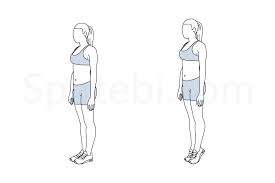
Your calf muscles and the back of your lower legs will get stronger with this workout.
Steps To Follow:
- Place your feet shoulder-width apart as you stand. For support, take a seat next to a wall or grasp the back of a chair.
- To stand on the balls of your feet, lift both of your heels off the ground.
- Bring your heels down to the beginning position slowly. When using this exercise to develop your calf muscles, control is key.
- Do 2 or 3 sets of 10 repetitions.
Curl of the hamstrings
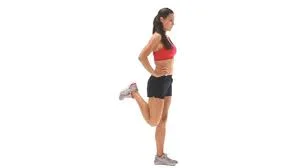
Your glutes and hamstrings are the focus of the standing hamstring curl. In order to maintain your hips and upper body stable, core strength is also necessary.
Steps To Follow:
- Face the wall while standing or get assistance from a chair. Place your feet hip-width apart.
- Raise one foot to the sky, flex your knee, and point your heel upwards. Maintaining your upper body still and your hips pointed forward, go as far as you can.
- For five to ten seconds, hold.
- Let go and return to the beginning position.
- Perform two or three sets of ten repetitions for each leg.
Leg extensions
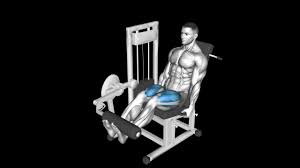
By strengthening your quadriceps using your own body weight as opposed to a weighted machine, you may reduce the strain on your knees.
Steps To Follow:
- In a chair, take a stance.
- Place your feet hip-width apart and flat on the ground.
- Without lifting your buttocks off the chair, look straight ahead, tighten your thigh muscles, and raise one leg as high as you can.
- After a little pause, return to the initial position.
- Perform two or three sets of ten repetitions on each leg.
Straight leg raises

Straight leg raises help to develop your hip flexor muscles and quads. Your shins should tighten as well as you flex your foot to finish the exercise.
You may increase the difficulty of this exercise by starting with a 5-pound ankle weight and working your way up to a bigger weight as your leg strength increases.
Steps To Follow:
- You may cushion your back during this workout by placing a pad underneath it.
- With one leg bowed and the other extended straight in front of you, adopt a floor position.
- Your straight leg’s quadriceps should be contracted as you gradually lift it off the ground to the same height as your bent knee.
- After a 5-second pause at the peak, return to the starting position.
- Perform two or three sets of ten repetitions on each leg.
Side leg raises
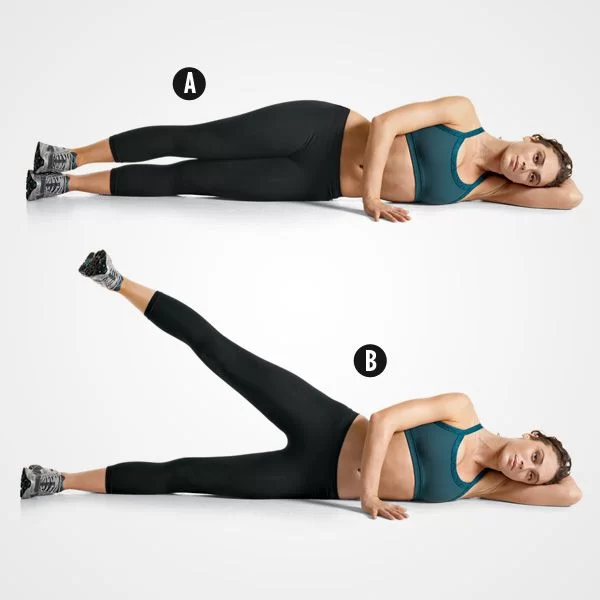
The hip abductor muscles are worked during this workout. The muscles on the outside of your hips called the hip abductors facilitate easy standing, walking, and leg rotation. Knee and hip discomfort may be avoided and treated by strengthening them.
You may increase the difficulty of this exercise by starting with a 5-pound ankle weight and working your way up to a bigger weight as your strength increases.
Steps To Follow:
- Lean on your side with your legs placed on top of each other.
- Hold your head with one hand as the other rests on the ground in front of you.
- Elevate your upper leg as high as it is comfortable for you. This ought to be felt on the side of your hips.
- After a little pause at the top, drop your leg.
- Perform two or three sets of ten repetitions on each leg.
Prone leg raises
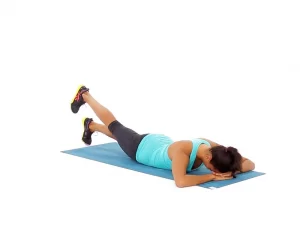
This is a workout that targets both your glutes and hamstrings. You may begin with a 5-pound ankle weight and work your way up to a bigger weight as the exercise becomes easier and your leg muscles are stronger.
Steps To Follow:
- A mat can be used to provide additional padding under you during this workout.
- Stretch your legs straight out behind you while lying on your stomach. You are welcome to place your head on your arms.
- Lift your left leg as high as you can without experiencing discomfort, utilizing your glute and hamstring muscles. Throughout this exercise, maintain your pelvic bones on the floor.
- For five seconds, maintain your leg up.
- Take a two-second break, lower your leg, and then repeat.
- Perform two or three sets of ten repetitions on each leg.
Lying knee bend
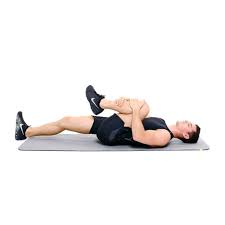
One of the best exercises for knee discomfort is the laying knee bend. Try doing it while lying down to obtain the maximum benefit. Say no more! The best location to do this workout is in bed.
Knee bending followed by straightening is one repeat. Your knee’s range of motion will improve with this workout.
Steps To Follow:
- Sliding your foot as far toward you along the floor or bed can help you to gradually bend the injured leg while maintaining a straight knee.
- Hold this position for two seconds, then extend your leg once more.
Clamshells
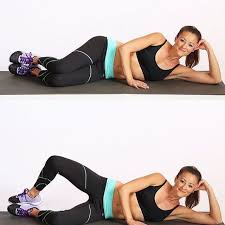
By strengthening the hip muscles, which can help minimize knee discomfort, the clamshell exercise is an excellent technique to lessen knee pain. By increasing muscular stability and flexibility, this exercise may assist in lessening localized pain.
Steps To Follow:
- Keeping your feet piled on top of one another and your knees bent at a ninety-degree angle, lie on your side.
- For added stability, rest one arm under your head while the other rests comfortably on top of your hip.
- Keeping your feet together, slowly raise your upper knee toward the sky until you feel the muscles.
- After holding this posture for five to ten seconds, carefully bring the knee back to its initial position.
- Continue this exercise ten to fifteen times for each leg.
- For best effects, try to finish the entire set of these two to four times a day.
Double Knee To Chest
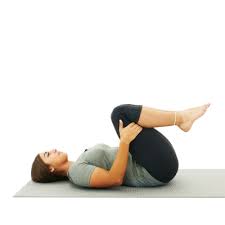
Steps To Follow:
- Laying flat on your back, extend your legs.
- Raise both knees to the same level, and rest your hands on the top of your shin just below the knee joint.
- One can also place your hand on your thighs’ backs.
- Return to your starting posture after bringing your knees slowly up to your chest and holding them there for 10 seconds.
Leg ADduction
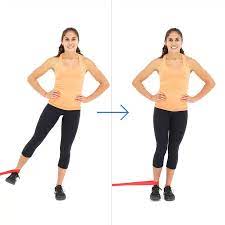
Steps To Follow:
- As shown, put one foot on the chair’s top and the other, resting on the ground.
- Raise the outstretched leg and press it on the bottom of the chair.
- After 10 seconds of holding, lower the leg back to the ground.
Unweighted Flexion
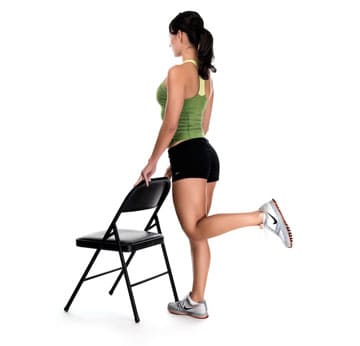
Steps To Follow:
- Utilizing the chair’s back as support, take a position behind it. Raise your left leg to a roughly 90-degree angle.
- hold it there for 10 seconds, and then return to the beginning posture.
- Perform 10 reps on each leg after switching them.
Ankle Stretch
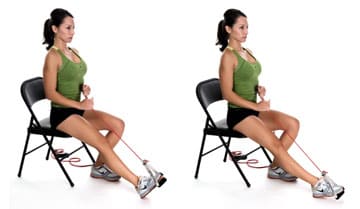
Steps To Follow:
- Over your right foot, place one end of a Sportcord at the instep (not the tip of the shoe).
- Pull up the Sportcord while extending your right leg to get the appropriate resistance and challenge.
- Step your right toe down as if you were driving and hitting the gas pedal.
- Repeat twenty times, holding out extended for five seconds each time.
- Then change.
Straight-Leg Piriformis Stretch
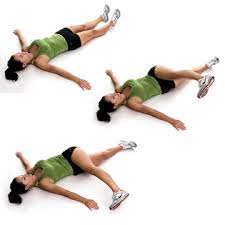
Steps To Follow:
- As indicated, lie on your back.
- Try to make your left leg contact the ground with your right hand as you raise it and bring it across your torso.
- Maintain a level shoulder to the ground. After holding for 20 seconds, go back to the beginning and repeat with the opposite leg. Perform ten iterations per leg.
Single Hamstring Stretch

Steps To Follow:
- As demonstrated, sit on the floor with your right leg bent and your left leg extended.
- Reach out and touch your left foot’s toes with both hands. Instead of bouncing, gently stretch.
- Return to the starting position after attempting to hold the stretch for 10 seconds.
- After ten repetitions, swap legs.
Alternative exercises for knee discomfort
- Once your knee strength has increased, you might want to incorporate low-impact exercises into your training regimen. Your joints will usually be under less stress from these workouts than from high-impact ones like jogging or leaping.
Low-impact workout examples include:
- Elliptical yoga
- Tai chi machine
- Walking
- Cycling
- Swimming
- Water aerobics
What further remedies exist for knee pain?
The underlying source of knee discomfort must be addressed in order to find relief. Apart from doing workouts at home, physicians could suggest:
- Employing a knee compression sleeve to reduce swelling and offer stability applying ice if it helps using nonsteroidal anti-inflammatory medicines (NSAIDs), either orally or topically, in the early days following injury
- Your knee discomfort may also be lessened with physical treatment. Physical therapy may be more helpful in lowering knee discomfort than at-home exercises, according to ResearchTrusted Source.
To enhance: A physical therapist can create and oversee an exercise regimen.
- Pain intensity
- Range of motion
- Strength
It can result from carrying excess weight, which places additional strain on the knees. To help you shed pounds and build stronger lower body muscles, your doctor can suggest a diet and exercise plan.
Conclusion
It may be possible to alleviate discomfort, increase your range of motion and flexibility, and lower your chance of further injury by engaging in stretching and strengthening activities that focus on the muscles that support your knees.
It is advisable to consult a physician or physical therapist for any kind of joint problems before beginning an exercise regimen. Based on the source of your discomfort and its associated factors, they can also suggest workouts and alterations.
FAQs
How can discomfort behind the knee be relieved?
Lifestyle choices and DIY solutions
Relax. To lessen the recurrent strain on your knee, allow the injury time to heal, and help avoid future damage, take a vacation from your regular activities.
Ice. Ice relieves pain and inflammation as well as heat, compression, and elevation.
Which exercises are recommended for soreness below the knee?
Never engage in physical activity that makes you more uncomfortable:
Knee to Chest Twice.
Exercise: Leg Cycle.
ADduction of the leg.
Flexion without weight.
Full Extension Knee Exercise.
Stretch your ankles.
Stretching only one hamstring.
Stretch your knees.
Can I get rid of my knee pain?
Young people who are engaged in society often suffer from sprains of the knee. In a football game, twisting a leg or kicking someone hard can inflame and hurt the back of the knee. Everyday sprains are frequent, and resting typically relieves the associated discomfort.
If my knee hurts in the back, should I still exercise?
You might not think of exercising if you have knee discomfort. You’re not alone either; according to doctors, just 13% of men and 8% of women with osteoarthritis in their knees receive the required amount of activity each week. However, the best thing you can do for your knees is to exercise.
Does knee pain go away as you walk?
Walking for exercise offers several benefits, particularly for senior citizens. It relieves joint strain and enhances cardiac health, circulation, and balance. Furthermore, a recent study indicates that walking may help prevent and lessen knee discomfort associated with osteoarthritis, the most prevalent kind of arthritis.
Reference
- Lindberg, S. (2023, May 8). 10 Exercises to Help Relieve Knee Pain. Healthline. https://www.healthline.com/health/exercises-for-knee-pain
- 11 Exercises to Reduce Knee Pain | Fort Worth Bone & Joint Clinic. (n.d.). https://thcboneandjoint.com/educational-resources/knee-exercises.html
- Physio, B. (2023, August 2). 7 exercises for knee pain. Benchmark Physio. https://benchmarkphysio.com.au/7-exercises-for-knee-pain/

